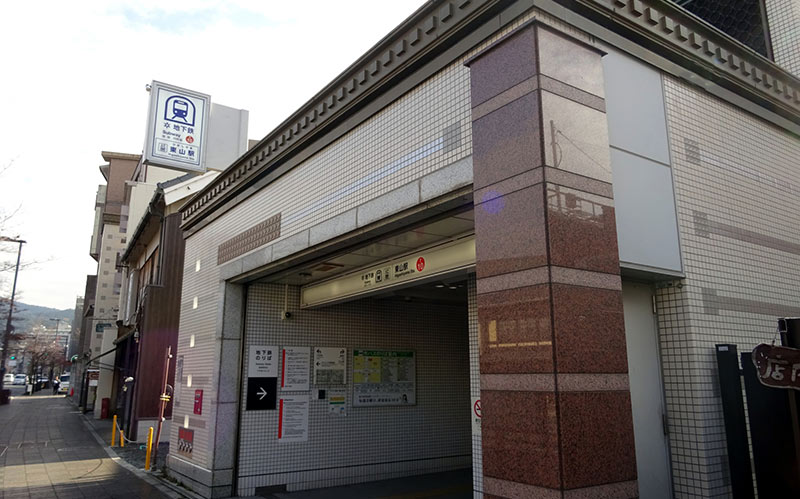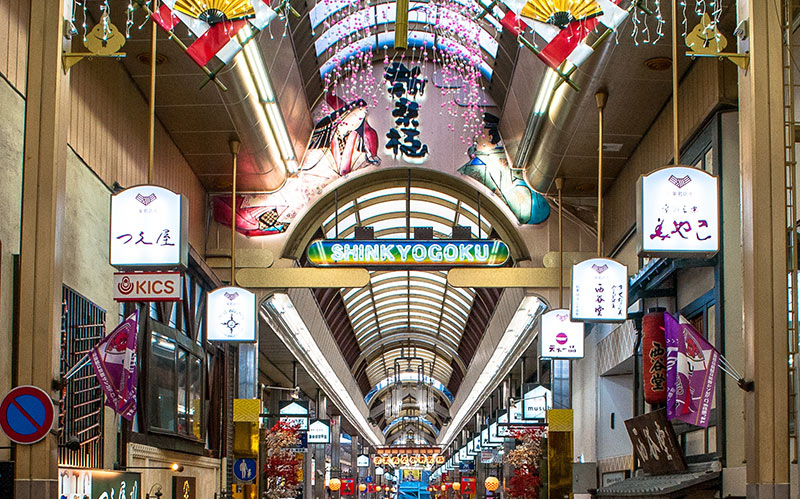This time we will stroll from Higashiyama Sanjo, near the center of Kyoto, to Shijo Dori, Kyoto’s largest downtown area. Higashiyama Sanjo is a little off to the north from the famous Gion area of Kyoto. It is convenient for both strolling and sightseeing, and you can get a sense of Kyoto just by walking around the area. From there, head for Nishiki Ichiba, the historic market known as “Kyoto’s kitchen. You will walk through a place lined with many stores where you can eat and walk around, so be sure to have a good appetite before you go for a stroll.
- Today’s route
- Stroll from Higashiyama Station to Shijo Station on the Kyoto Municipal Subway
- A.Kyoto City Subway Higashiyama Station
- B. Chion-in Temple with many important cultural properties and national treasures
- C.Yasaka Shrine, known as the god of business prosperity
- D. Café Soiree with attractive signage
- E. Nishiki Tenmangu Shrine, dedicated to the god of learning
- F. Nishiki Market, a food district with a long history
- G. Kyoto Municipal Subway Shijo Station
- Review of “Kyoto’s Kitchen” stroll from the streets of Kyoto
- Stroll link to “Kyoto’s Kitchen
Today’s route
A.Kyoto City Subway Higashiyama Station
B.Chion-in Temple
C.Yasaka Shrine
D.Cafe Soiree
E.Nishiki Tenmangu Shrine
F.Nishiki Market
G.Shijo Station, Kyoto Municipal Subway
Stroll from Higashiyama Station to Shijo Station on the Kyoto Municipal Subway
A.Kyoto City Subway Higashiyama Station
This stroll will begin at Higashiyama Station on the Kyoto Municipal Subway Line. Higashiyama Station is located a little far from downtown Kyoto, yet close to famous temples, shrines, and Buddhist temples. It is not as busy as the city center, so the atmosphere is more relaxed, as is typical of Kyoto.

Let’s go out of Higashiyama Station and walk along the riverside path to the west. The path is planted with willow trees and is very beautiful during the season of fresh green.

As you continue south, you will see the historic “Old Gate of Chion-in Temple” on your left. Pass through the old gate and continue straight ahead.
As the name of the gate suggests, this road leads to the ancient temple Chion-in. Although Chion-in Temple is a well-known place, most visitors to Chion-in Temple choose the Chion-in Road, which is a little further south. Therefore, this road is relatively quiet. Nevertheless, the scenery on either side of the road reminds us of the long history of the temple.

From the “Black Gate” at the end of the road, let’s visit our first destination, Chion-in Temple.
B. Chion-in Temple with many important cultural properties and national treasures
Chion-in Temple is located a little east of Higashioji Dori (also known as Higashiyama Dori), a major street in Kyoto. It is also one of the most famous sightseeing spots in Kyoto, not far from the famous Gion flower district.

Chion-in Temple was founded about 800 years ago and is one of the most famous ancient temples in Kyoto. It is the head temple of the Jodo sect of Buddhism, and it is said that Honen Shonin established a hermitage there.
The highlight of the temple is the numerous halls that line the temple grounds. Many of them are designated as national treasures or important cultural properties, and the sight is truly spectacular. The Mikado Hall, built by Tokugawa Iemitsu, has undergone a nine-year renovation and will reopen to the public in 2020.
The precincts of the temple are basically free to visit (except for two gardens). Visitors can take their time to walk through the spacious precincts, taking in the long history of the temple as they view the historic buildings. In addition, there are legends in Chion-in called the Seven Wonders, such as the “Forgotten Umbrella”. You can enjoy your visit to the temple more if you look them up before visiting.
When you have finished strolling around Chion-in Temple, go out of Sanmon Gate and walk straight west to Higashioji Dori. As you go left on Higashioji Dori, you will see a large, beautiful vermilion gate on your right. This is Yasaka Shrine, your next destination.

C.Yasaka Shrine, known as the god of business prosperity
Yasaka Shrine has long been known and loved as “Gion-san” or “Yasaka-san. Along with Fushimi Inari and Kiyomizu-dera, many people know it as a synonym for Kyoto.

In Japan, there is a belief called “Gion worship. This belief worships Susano-no-mikoto and Ushitotenno, and shrines with these deities as their main deities are called Gion-sha or Gion-jinja. Yasaka Shrine is said to be the head shrine of the Gion Shrines (there are various theories).
Yasaka Shrine has long been a favorite of the local people as a god of business prosperity. It is said to have been founded in 656, and was originally intended to contain illnesses that were prevalent in the capital.
Yasaka Shrine is characterized by the colors used throughout the shrine grounds. Vivid vermilion is used throughout the shrine grounds, including the gate facing Higashioji Dori and the main shrine pavilion, attracting the attention of passersby.
In addition, there are a number of subordinate shrines enshrined in Yasaka Shrine. The most representative are “Okuninushi Shrine,” which is said to be responsible for marriage, and “Bigozensha Shrine,” which is said to have a spiritual power for beauty. Women are encouraged to visit these shrines while touring the shrine grounds.


When you have finished exploring Yasaka Shrine, let’s move on. To reach your next destination, you will pass through Shijo Dori, which forms the busiest shopping street in Kyoto.
Exit the gate of Yasaka Shrine and walk straight west on Shijo Dori. Walk through the streets of Gion, the flower district, with the streets of Gion stretching out to the left and right. After walking for a while, you will see the Minami-za Theater on your left. This theater has been in operation since the Edo period (1603-1867), and Kabuki performances are still held there today.
Right next to the Minami-za is a large bridge called the Shijo Ohashi. Cross this bridge and go north at the second traffic light. After a short walk, you will see “Cafe Soiree” on your left, which has a Showa-era atmosphere.
D. Café Soiree with attractive signage
Café Soiree is a long-established coffee shop established in 1948. Soothe your tired feet after all this walking with a stylish, relaxed Showa-era atmosphere and delicious beverages.
The interior of Soiree is filled with a distinctive blue color. And the specialty of this store is Jelly Punch, a colorful jelly in soda water. The Jelly Punch is a work of art in the blue lighting.
In addition to Jelly Punch, Soiree offers a variety of other drinks. Why not choose your favorite drink and escape from reality for a while?

When you feel energized after a short rest, leave the store and walk south on Shijo Dori again.
Exit on Shijo Dori and walk west with your back to Yasaka Shrine. The next major intersection is Shijo Kawaramachi. This is one of the busiest intersections in Kyoto.
Continue straight through that intersection and turn right at the intersection called “Shinkyogoku. This street is called Shinkyogoku Dori and is an arcade lined with many stores.

Walking for a while through the crowds on Shinkyogoku Dori, you will see Nishiki Tenmangu Shrine with many hanging lanterns on your left.
E. Nishiki Tenmangu Shrine, dedicated to the god of learning
Nishiki Tenmangu Shrine is located in the shopping district of Kyoto and at the entrance to a famous shopping street. Dedicated to Sugawara no Michizane, the god of learning, the shrine has long been worshipped by the people.
Nishiki Tenmangu Shrine was founded around the 10th century. At that time, it was located in Kawaramachi Gojo, south of where it stands today, and it is believed that it was moved to its present location around the 16th century.


It is a very small shrine with only 200 tsubo (about 1,000 square meters), and you can quickly look around the shrine grounds. After visiting the shrine, you can draw the famous “karakuri omikuji” (a kind of omikuji). This omikuji is fun to watch as you insert coins and the lion dance begins to move along with the clapping of the beats. There are several types of omikuji available, so you can choose the one you like best.
After visiting the shrine, leave the precincts and proceed straight ahead to the Nishiki Market.
F. Nishiki Market, a food district with a long history
Nishiki Market, which can be seen directly in front of the Nishiki Tenmangu Shrine, is a large shopping street with food stores lined up within its approximately 400 meters. For about 400 years since the market was established, it has been known as “Kyoto’s kitchen” as a place that supports Kyoto’s food culture.

It is usually loved not only by professional chefs but also by the general public, and in recent years the number of tourists has been increasing. For this reason, there are many stores where you can eat and walk around, and one of the pleasures of walking around the market is to browse through the various products.
Inside Nishiki Market is a lively place where locals and tourists mingle. Its atmosphere is quite different from other downtown areas, with the smell of long history mixed with modern elements.
This place is so crowded that at the worst of times you have to walk between people. But if you come to Kyoto and take a stroll in Kyoto, it is a place filled with an atmosphere that you should experience at least once.

In this stroll, we entered Nishiki Market from Shinkyogoku Dori. Then go straight ahead and continue through the shopping street. After passing through the shopping street, you will come to a large street. This is Karasuma Dori.
G. Kyoto Municipal Subway Shijo Station
After passing Nishikikoji Dori, where Nishiki Market is located, up to Karasuma Dori, turn left!
This area is more like an office district than a downtown area. Continuing on, you will come to the intersection of Shijo-Karasuma. This is a large intersection with a unique atmosphere, surrounded on three sides by majestic buildings.


The Kyoto Municipal Subway, Shijo Station, which is the goal of Kyoto, can be entered through the entrance at this intersection. Good night.
Review of “Kyoto’s Kitchen” stroll from the streets of Kyoto
A. (Start) Higashiyama Station, Kyoto Municipal Subway
↓ 550m
B.Chion-in Temple
↓ 550m
C. Yasaka Shrine
↓ 700m
D. Cafe Soiree
↓ 450m
E. Nishiki Tenmangu Shrine
↓ 30m
F. Nishiki Market
↓ 800m
G. (Goal) Kyoto Municipal Subway Shijo Station
Stroll link to “Kyoto’s Kitchen
Jodo sect head temple Chion-in official site Here
Yasaka Shrine official site Here
Soiree cafe official site Here
Nishiki Tenmangu shrine official site Here
Nishiki market shopping street official siteHere
